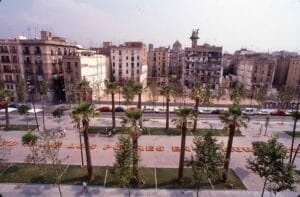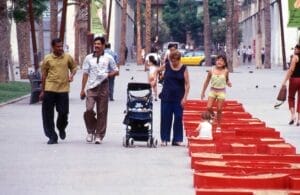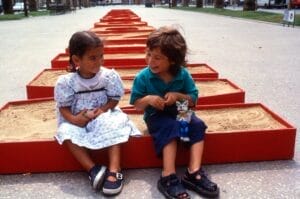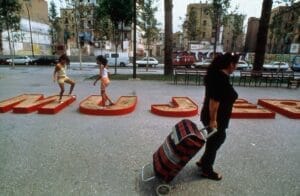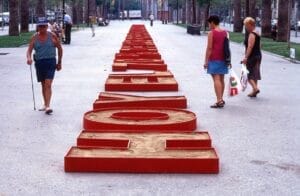Esto nos salvará (This will save us)
The outdoor garden installation ESTO NOS SALVARÁ (THIS WILL SAVE US) (2023) was developed as a collaborative project between Galeria Ana Serratosa and Kewenig for the city of Valencia.
Situated along the picturesque Turia riverbed, this garden offers a striking contrast to the iconic Neo-Futurist architecture of Santiago Calatrava and Felix Candela which has defined the City of Arts and Sciences for years. With her garden, Ghada Amer draws our attention to a message outlined in iron letters in the shape of a seasonal vegetable garden. It invites viewers to engage and contemplate our relationship with the earth and its role for our future. Food in the urban landscape is what will save us. The garden sends a timely ecological message.


Versions
2023
Galeria Ana Serratosa and Kewenig for the city of Valencia
My Body My Choice
This garden installation takes up the well-known battle cry promoted by the women’s and gender equality movement since the 1970s “my body my choice” and spells each of its letters in a red resin box filled with plants. While over the past fifty years, this tagline has been co-opted by a number of groups around the world with entirely contradictory agendas, Ghada Amer’s garden, like her art in general, reminds us of the early intent of the mantra, that of promoting women’s rights and equality.
According to Ghada Amer: “In Western societies, there is an assumption, especially among the younger generations, that the battle of the sexes has been won, that women have been liberated, and that their rights are secure. And yet, we are witnessing today a sharp regression of women’s rights and a stark rise of violence against women. However, in countries where one assumes women’s rights to be limited or absent, such as in Egypt, Iran, Afghanistan, or Mexico, women of the younger generation know they have a lot to gain from fighting for those very same rights that are eroding in the West. So they are not letting down their guard and they are continuing to fight fiercely.”
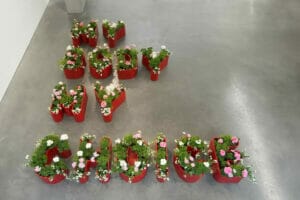
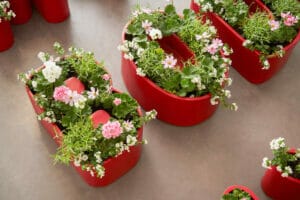
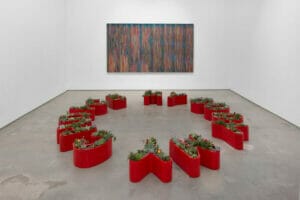


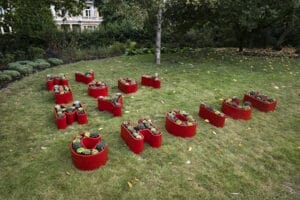
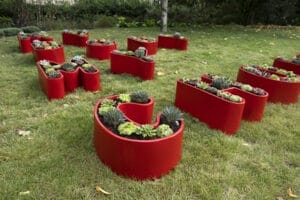
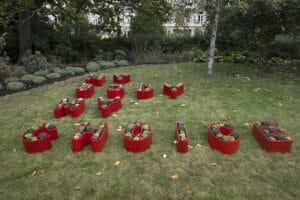
Versions
2022
Solo Show-Goodman Gallery, London
2022
Marianne Boesky Gallery, New York
2023
Frieze Regents Park, London
Hoy el 70% de los pobres en el mundo son mujeres
[Today 70% of the Poor in the World are Women]
This installation uses sand boxes instead of flower beds and spells out the titled statistical statement. Each letter of this statement became a sand box measuring 1×1 meter and was made of red painted timber, serving both as a sculpture and a playground for children. The complete statement could only be read from an aerial view or slowly as one walked along.
This garden was installed along a wide Boulevard in Barcelona in the middle of an economically and socially depressed area of the city, with the hope of reviving it. It invites us to reflect on the gendered distribution of wealth globally, including in the so-called First World.
This garden project [Today 70% of the Poor in the World are Women] was produced three times:
Versions
2001
Curated by Rosa Martinez
La Rambla del Raval
Barcelona, Spain
2020
Part of the International Women’s Day Celebrations
MAZ (Museo Arte Zapopan)
Zapopan, Mexico
2022
Part of the International Women’s Day Celebrations
Museu de Arte e Historia de Guanajuato
León, Mexico
Love Grave
Despite the inclusion of the word “love” in the title of this garden, Ghada Amer insists that her intent in this installation is primarily to speak about the violence and absurdity of wars and their effect on human lives. This garden, along with Peace Garden (2002) and S’il Pleuvait des Larmes (2004), speaks directly to armed conflicts, and especially about the “War on Terror” begun by Georges W. Bush in 2003 and the long Iraq war.
This garden was created by digging the capital letters of the word “love” six feet into the ground as though preparing it for the burial of that four-letter word. The dichotomy inherent in spelling the word “love” by means of a symbol of death calls attention to the connections between Eros and Thanatos, between love and death, plenitude and emptiness. It alludes both to the oft-unavoidable ending of love stories and the outcome of wars where we inevitably lose loved ones.
The Love Grave garden was produced four times:
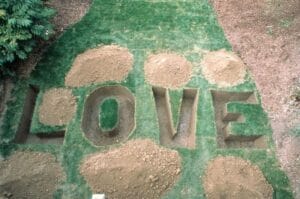


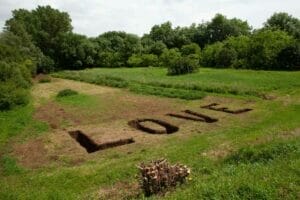
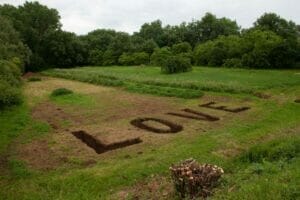

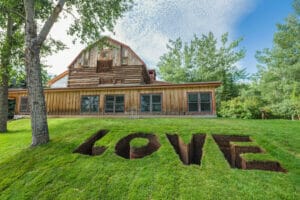

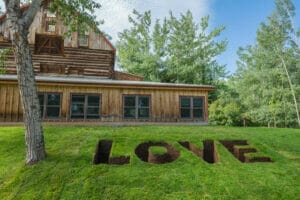

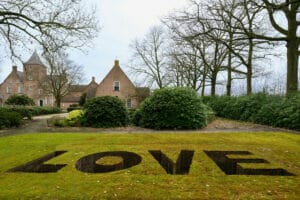
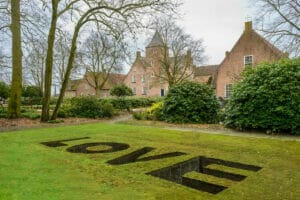
Versions
2003
Forefront 45, curated by Lisa Freiman
Indianapolis Museum of Art
Newfields, Indianapolis, USA
2018
Eighth Biennale of Melle, France
Le Grand Monnayage, curated by Chloé Hipeau-Disko and Frédéric Legros
Melle, France
2020
Sculpturally Distanced, curated by Lisa Ballinger
Anderson Ranch Arts Center
Snowmass Village, Colorado, USA
2023
H3H Biennale Oosterhout- Faith, curated by Hendrik Driessen and Rebecca Nelemans
Monasteries of the Heilige Driehoek
Oosterhout, Netherland
All Oppression Creates a State of War
Invited to create a garden installation for the first Biennale of Rabat, Morocco, Ghada Amer chose the nineteenth century fort (Fort Hervé) for her new artistic production. This fort, the first concrete construction in Africa, was an especially apt space for her installation because a military fortification is by definition a male space, one reminiscent of battles, attacks from enemy forces and oppressive regimes.
For this installation, Ghada Amer selected a citation (“All Oppression Creates a State of War”) from one of her favorite French philosophers, Simone de Beauvoir. While de Beauvoir was referring primarily to gender and female oppression, Ghada Amer expands this notion to all sorts of oppressions, including especially political oppression and military regimes under which many African nations still live. Situating this political reference inside a fort is a particularly judicious choice.
This installation is composed of the block letters from Simone de Beauvoir’s citation built as though each letter was a flowerbed. The shape of the entire citation follows the circular contours of the fort rampart. Each flowerbed is filled with hardy, salt, wind and sun resistant local plants.
Versions
2019
First Biennale of Rabat: Un Instant avant le monde, curated by Abdel Kader Dahmani
Fort Hervé
Rabat, Morocco
Cactus Painting
Just as the title indicates, this garden is intended as a new language of painting, a painting with flowers, or in this case with prickly cacti. It is in its third and largest rendition in 2018 that this garden achieves its most complete meaning, as a profound critique of the history of painting by white, male, Anglo-Saxon artists that excluded women from the practice. The gigantic dimension of the garden made up of 16000 cactus plants interrogates the place of women artists in postwar American abstract painting. The abstract geometrical design of the garden, while paying lip service to large cartesian paintings such as those by Frank Stella or Josef Albers’ “Homage to the Square” (1950-1976), artfully challenges the formal precision of abstraction. Ghada Amer uses geometry and abstraction to paint sexual forms with her cacti: Her green phallic cacti stand proudly amidst large red leaves, evocative of vaginas. Ghada Amer does not shy away from the sexual allusion of her piece, calling in fact her assemblage a “phactus” (phallus + cactus).
The gigantic 2018 rendition of Cactus Painting required a team of 25 members to produce and a full 5 days of work before the design of the installation could emerge. The team worked from a drawing by the artist, and used conventional techniques of cloth weaving to produce the garden, crisscrossing the space of the installation with weft thread (for the width) and warp thread (length).
The Cactus Painting garden was produced four times:

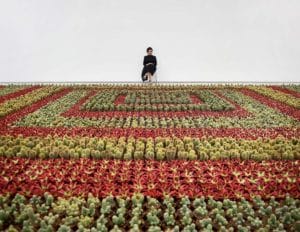
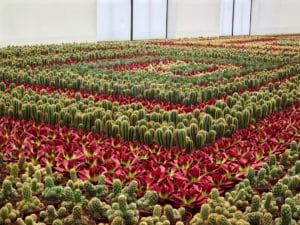
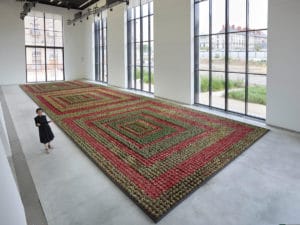


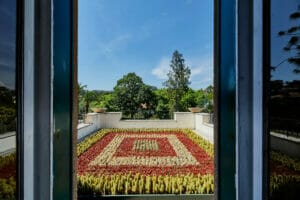
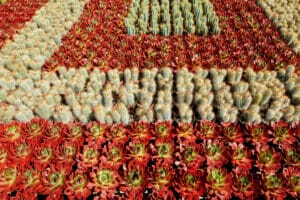


Versions
1998
Curated by Rosa Martinez. Outside garden (projected to be 70m x 70m) at the Mar de Fondo group exhibit held at the Roman Theater of Sagonte, Valencia, Spain.
This garden was unfinished due to budgetary cuts that did not permit the purchase of all the cacti (Cactus Elongatas and Verdologas) that were needed.
2000
Indoor garden at the Ghada Amer: Monographie et Jardins solo show at the Centre de Création Contemporaine (CCC), Jardin du Musée des Beaux-Arts de Tours, Tours, France.
This was again an incomplete project due to time constraints, lack of space, and insufficient natural light for the cacti to grow properly.
2018
Gigantic indoor garden installation (16000 cacti): Solo show, Ghada Amer: Dark Continent in the Centre de Création Contemporaine Olivier-Debré (CCCOD), Tours, France (2018).
2022
5ème Biénnale des arts 2022 - Les fleurs du mâle, curated by Elodie Antoine
Musée d'art Naïf, Nice, France (2022).
Hunger
Invited by the National Museum of African Art to create an “Earthwork,” that is a large sculptural work which uses earth as material. Ghada Amer chooses to focus her sculpture on the subject of hunger. She highlights a global problem at the same time that she alludes to a specific issue: the fact that politicians in her native Egypt and elsewhere prey on the hungry by promising food in exchange for votes. Bags of rice and other edibles are therefore bartered for political support.
At the same time, by creating this garden, Ghada Amer hopes to remind visitors of the intimate connection between food and the earth. As she repeats, “food comes from the earth and not from the supermarket.” Her aim is to bring crops to the center of cities and to feed people from local productions.
In this installation, Ghada Amer carves the letters of the word “Hunger” on the lawns of the Smithsonian gardens in Washington, D.C and fills them with rice plants. At first, visitors can only see and read the letters of the word “Hunger.” However, as the plants grow, the word Hunger disappears, replaced with rice plants, ready to be harvested. In other words, crops erase hunger. (Because this site specific installation was to last for one entire year, rice was planted during the summer months, and was to replace with kale for the winter months).
Ghada Amer intended to gather visitors around a rice meal, harvested from her garden installation. That plan was squashed however. Ducks and birds happily moved in faster than human guests and they feasted on the unexpected plantation in the midst of the burgeoning city. “Nature always wins,” observes Ghada Amer with a smile.
Versions
2013
Part of the show Earth Matters: Land as Material and Metaphor
curated by Karen Milbourne
National Museum for African Arts and Smithsonian Gardens
Hirshhorn Museum and Sculpture Garden,
Smithsonian Institute, Washington D.C, USA
S’il Pleuvait des Larmes
For this garden installation, Ghada Amer frescoed the entire poem of Boris Vian (1920-1959) If it rained tears [LYRICS] in Italian on the existing structure of an abandoned garden located inside a monastery. While in his poem, Boris Vian was speaking about the destruction caused by the second world war, Ghada Amer alludes in her installation to the War on Terror and the Iraq War initiated by the United States in 2003 and in homage to all the dead civilians, casualties of war.
Ghada Amer explains that she built this garden as though it was a Muslim tomb, without much adornment, or like a monument in tribute to all dead soldiers, a sort of tomb of the unknown Iraqi soldiers.
Versions
2004
Curated by Achile Bonito Oliva
Certosa di San Lorenzo [Monastery of San Lorenzo]
Padula, Italy
Peace Garden
Peace Garden was presented at the Miami Botanical Garden in Florida and opened coincidently during the US invasion of Iraq. The garden consists of a peace symbol, as in “ban the bomb,” made of carnivorous plants. On the day the show opened, the garden became a site of a performance organized by Ghada Amer where she and three assistants served live worms and crickets to visitors to feed the plants. The use of carnivorous plants to construct a peace sign represents the shift in attitude from an earlier generation that promoted and used this symbol but then, over time, came to take peaceful ideas much less seriously.
Versions
2002
Art Basel Miami Beach
Miami Beach Botanical Garden
Miami, Florida, USA
Six Chinese Proverbs
Ghada Amer visited Panama City in 2003 where she was invited to create a garden as part of a show entitled Multiple City – Arte Panama, curated by Gerardo Mosquera and Adrienne Samos. The exhibit was intended to celebrate the one hundredth year of the independence of the Panama Canal. When she toured the city, Ghada Amer was impressed by the amount of green spaces in the capital and thus decided that instead of creating a literal garden with plants and flowers, she would use the lush urban landscape as a background to an installation with a pointed political message.
“Six Chinese Proverbs” is Ghada Amer’s contribution to the project, an installation she conceived in collaboration with local bus painters.
To understand Ghada Amer’s project, one must first understand the specific role that bus painters actually play in Panama society. Bus painters are professional painters who are not considered artists in their own right even though they paint private city buses as well as large murals on a number of city walls. They are regularly sought after by private bus drivers who pursue grandiose ways to personalize their vehicles. This is how the process often goes: Bus drivers give bus painters a photograph of a person, a family member, a pet, or even an object that is dear to them. They ask bus painters to use the photo as a source of inspiration for the painting. Stimulated by the photograph, bus painters use their full imagination to devise a composition that will decorate Panama private city buses.
Ghada Amer was fascinated by this tradition and by the endemic artistic and quasi-shamanic role played by bus painters in Panama. After all, the very existence of bus painters complicates our understanding of who counts as an artist and their work confounds the conventional opposition between high and low art, abstract and decorative painting. Because her own art regularly questions these very definitions and categorizations, Ghada Amer was compelled to work with Panama bus painters to develop the installation she had conceived.
Ghada Amer intended to make a political statement on Panama society and culture. She thus looked for inspiration from the farthest away culture from Panama that she could imagine and decided on China. Ghada Amer selected six Chinese proverbs (which she translated into Spanish) and she asked Panama bus painters to paint them on large billboards to be set up at strategic urban locations across Panama City. Ghada Amer did not realize that the paintings that Panama bus painters would end up producing would include more than just the text she had given them to paint. Evidently, they had understood fully Ghada Amer’s installation and the pointed political commentary that it conveyed and they played the game.
The powerful socio-political messages displayed on the billboards and their strategic locations across the city of Panama swiftly drew the attention of the Panama government. Before any professional photography could be taken of the final project (the billboards in the city set up in their selected location), Ghada Amer’s installation was censored and the six billboards confiscated and likely destroyed. The only archival documentation that has survived of Ghada Amer’s Panama City installation are the low resolution photographs she took. They are the ones shown here.
This installation was produced once.
The six Chinese proverbs are:
- Poverty without complaint is hard just as wealth with arrogance [set on Punta Pacific Avenue which divides a lower class neighborhood from a wealthier development]
- For the love of money, truth will fall silent [set at the comptroller’s office in Bocalacaja, a fishing neighborhood whose population was cut off from the ocean when a highway was built]
- What you see is real, what you hear might not be. [set in front of a church].
- Occupy the higher ground to exercise control [ set at the Panama canal administration building]
- Peace only comes when reason rules [set between the University of Panama and the Technology university, a street known for its riots]
- If one eats less, one will taste more [set near a McDonald’s and a Wendy’s]
Versions
2003
Part of group show: Ciudad Multiple City [various areas in the city]
curated by Gerardo Mosquera and Adrienne Samos.
Arpa Foundation
Panama City, Panama

